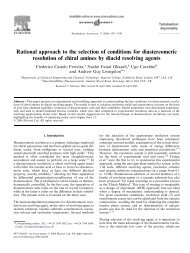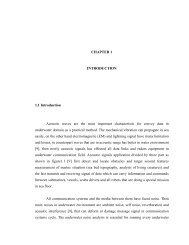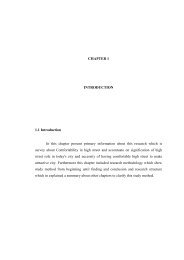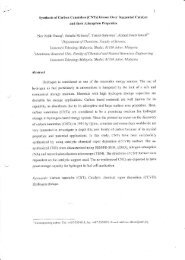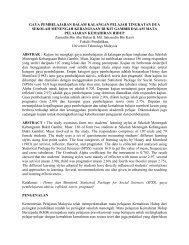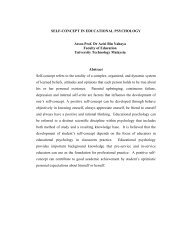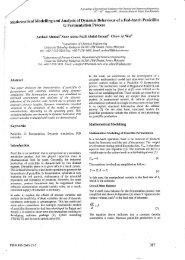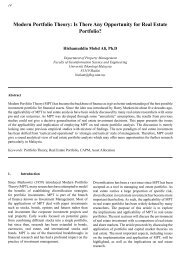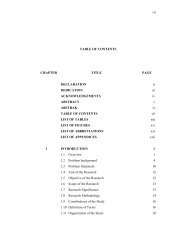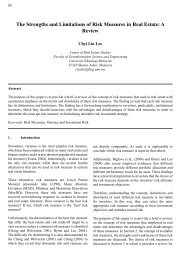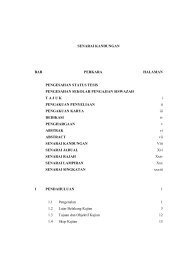Comparison of Signal-to-noise, Blank Determination, and - Universiti ...
Comparison of Signal-to-noise, Blank Determination, and - Universiti ...
Comparison of Signal-to-noise, Blank Determination, and - Universiti ...
Create successful ePaper yourself
Turn your PDF publications into a flip-book with our unique Google optimized e-Paper software.
LOD ≅ x + 3s<br />
bi<br />
bi<br />
bi<br />
LOQ ≅ x + 10s<br />
where i b x is the mean concentration <strong>of</strong> the blank <strong>and</strong> sb<br />
is the st<strong>and</strong>ard deviation <strong>of</strong> the blank.<br />
i<br />
Linear regression<br />
For a linear calibration curve, it is assumed that the instrument response y is linearly related<br />
<strong>to</strong> the st<strong>and</strong>ard concentration x for a limited range <strong>of</strong> concentration. It can be expressed in a<br />
model such as:<br />
y = a + bx<br />
This model is used <strong>to</strong> compute the sensitivity b <strong>and</strong> the LOD <strong>and</strong> LOQ (6). Therefore the<br />
LOD <strong>and</strong> LOQ can be expressed as:<br />
3s<br />
LOD ≅<br />
b<br />
a<br />
10s<br />
LOQ ≅<br />
b<br />
where s a is the st<strong>and</strong>ard deviation <strong>of</strong> the response <strong>and</strong> b is the slope <strong>of</strong> the calibration curve.<br />
The st<strong>and</strong>ard deviation <strong>of</strong> the response s can be estimated by the st<strong>and</strong>ard deviation <strong>of</strong><br />
a<br />
either y-residuals, s or y-intercepts, s <strong>of</strong> regression lines. This method can be applied in<br />
res<br />
y0<br />
all cases, <strong>and</strong> it is most applicable when the analysis method does not involve background<br />
<strong>noise</strong>. It uses a range <strong>of</strong> low values close <strong>to</strong> zero for calibration curve, <strong>and</strong> with a more<br />
homogeneous distribution will result in a more relevant assessment.<br />
Experimental<br />
St<strong>and</strong>ards <strong>and</strong> reagents<br />
The reference st<strong>and</strong>ards for <strong>to</strong>luene, ethylbenzene, iso-propylbenzene, n-propylbenzene <strong>and</strong><br />
styrene with a purity higher than 98% were supplied by Kan<strong>to</strong> (Tokyo, Japan).<br />
Dichloromethane (DCM) (Ultra-resi-analyzed grade) was obtained from J.T. Baker (USA). A<br />
s<strong>to</strong>ck solution <strong>of</strong> 1000 µg/mL in DCM was prepared separately for the five test compounds.<br />
A mixture solution at a level <strong>of</strong> 10 µg/mL was prepared from the s<strong>to</strong>ck solution above using<br />
the same solvent. A series <strong>of</strong> working st<strong>and</strong>ard solutions ranging from 0.2 µg/mL <strong>to</strong> 4.0<br />
µg/mL were prepared from the mixture solution (10 µg/mL) by dilution in DCM.<br />
Instrument <strong>and</strong> chroma<strong>to</strong>graphic conditions<br />
A Shidmazu (Kyo<strong>to</strong>, Japan) Model 17A gas chroma<strong>to</strong>graph equipped with flame-ionization<br />
detec<strong>to</strong>r (FID) <strong>and</strong> a Shimadzu AOC-20i au<strong>to</strong>sampler was used. A CP-WAX 52CB WCOT<br />
a<br />
bi<br />
3



